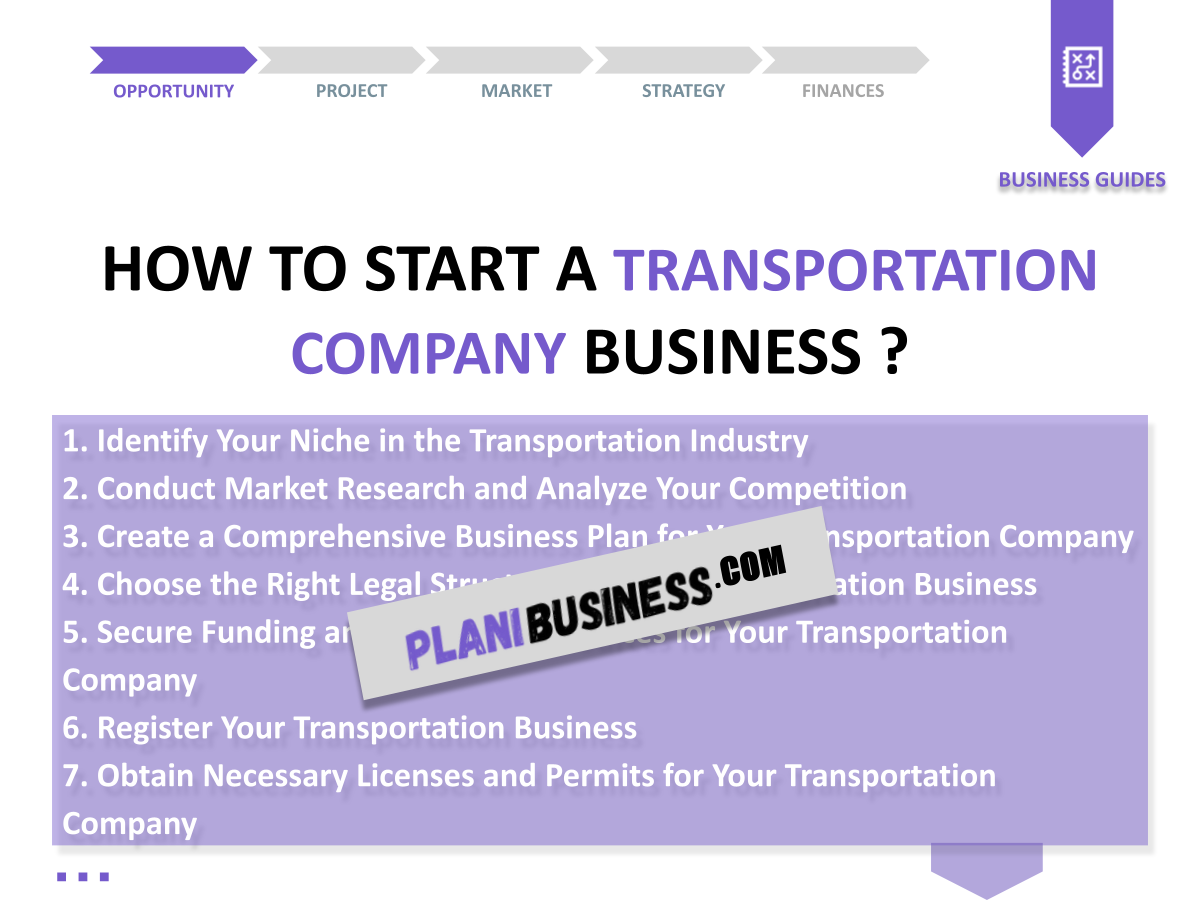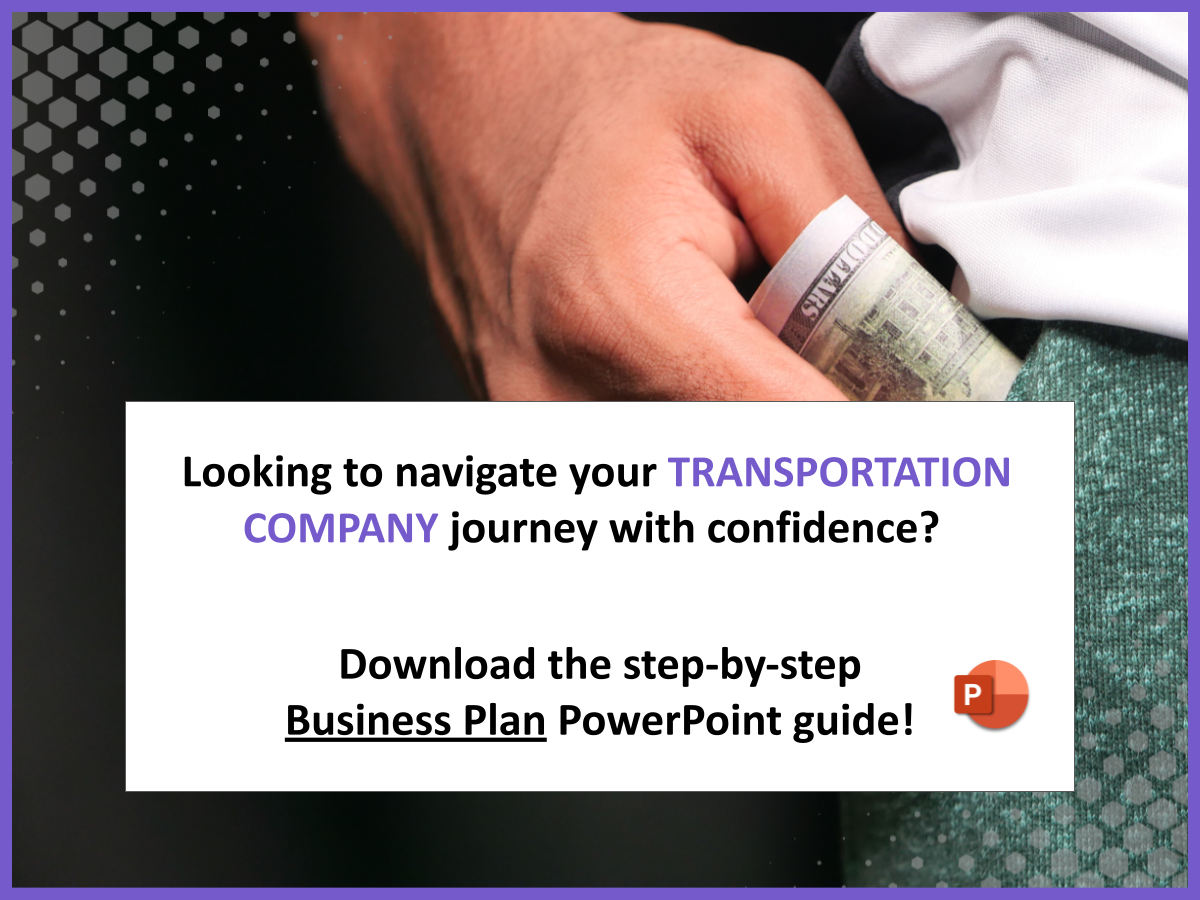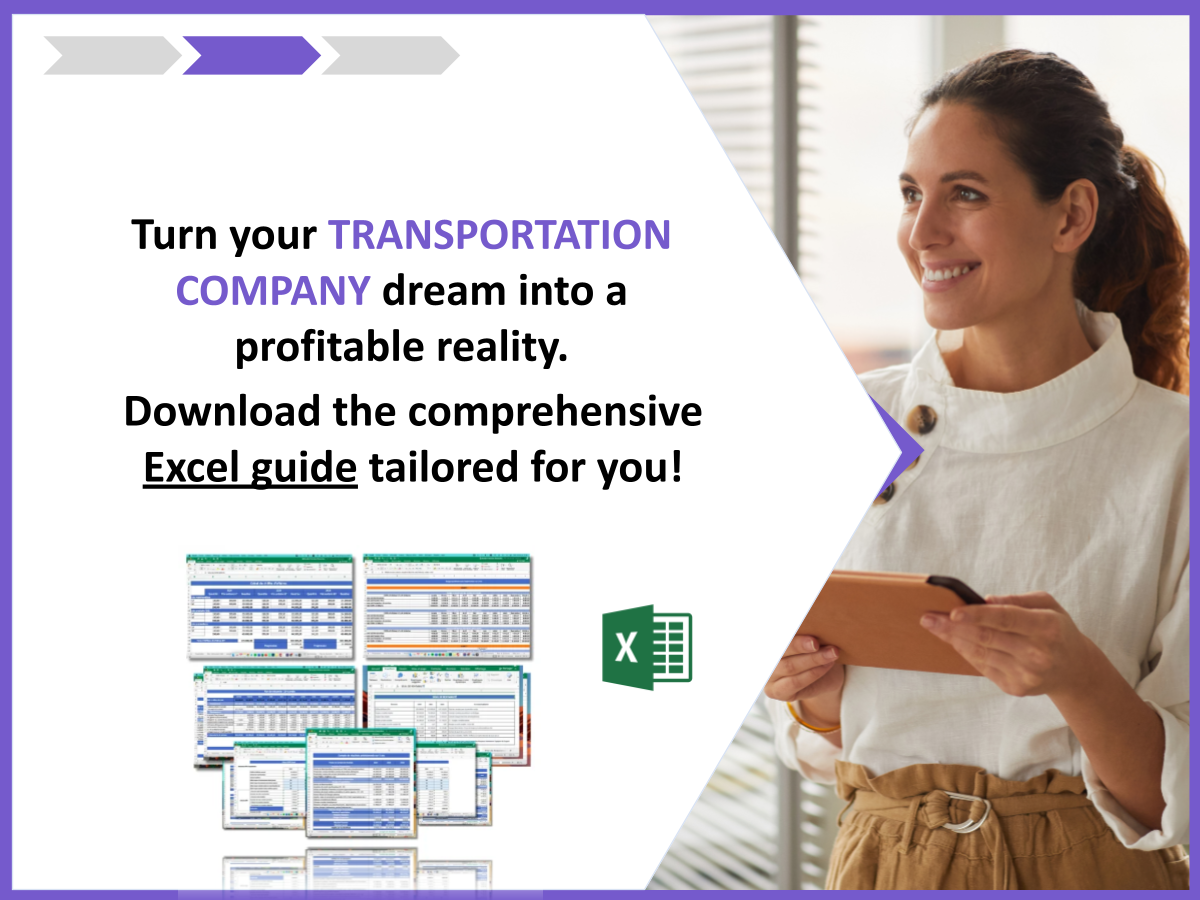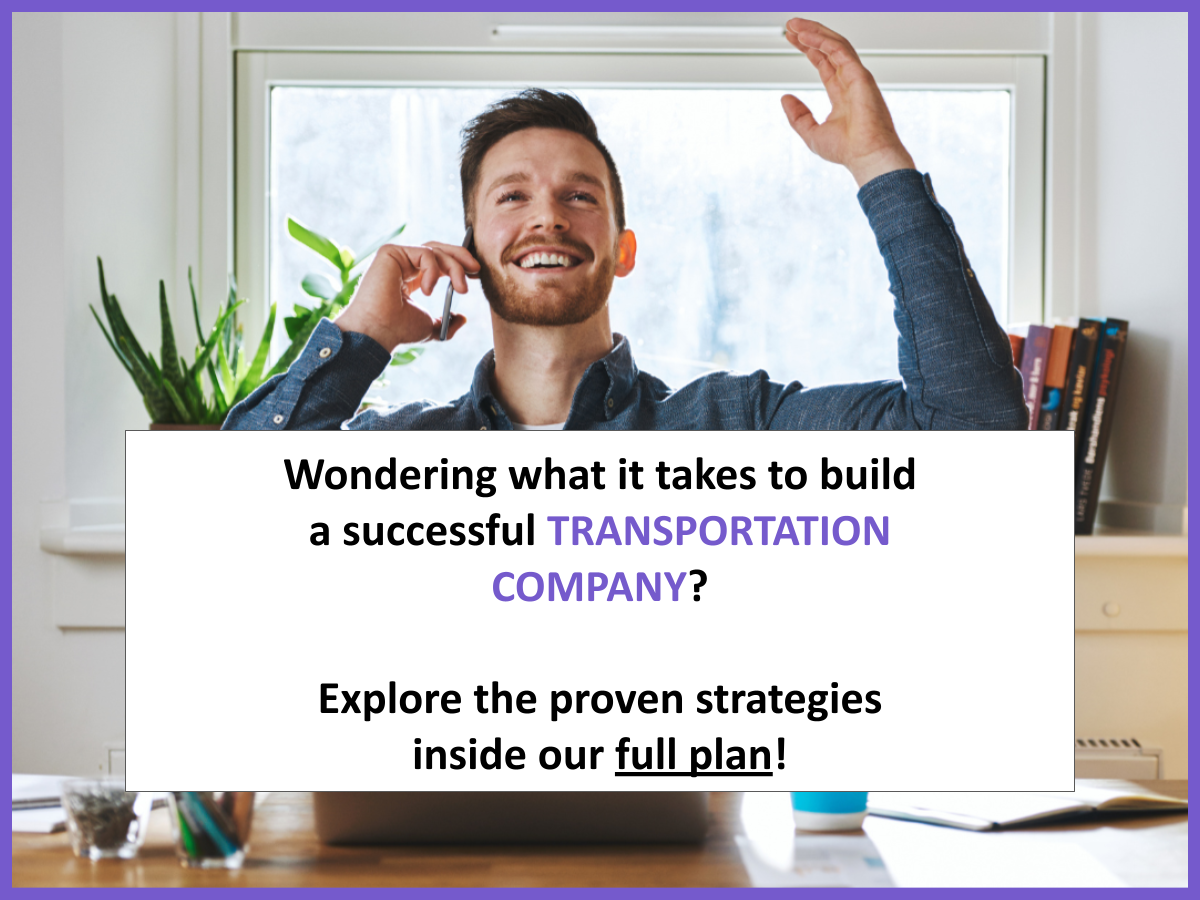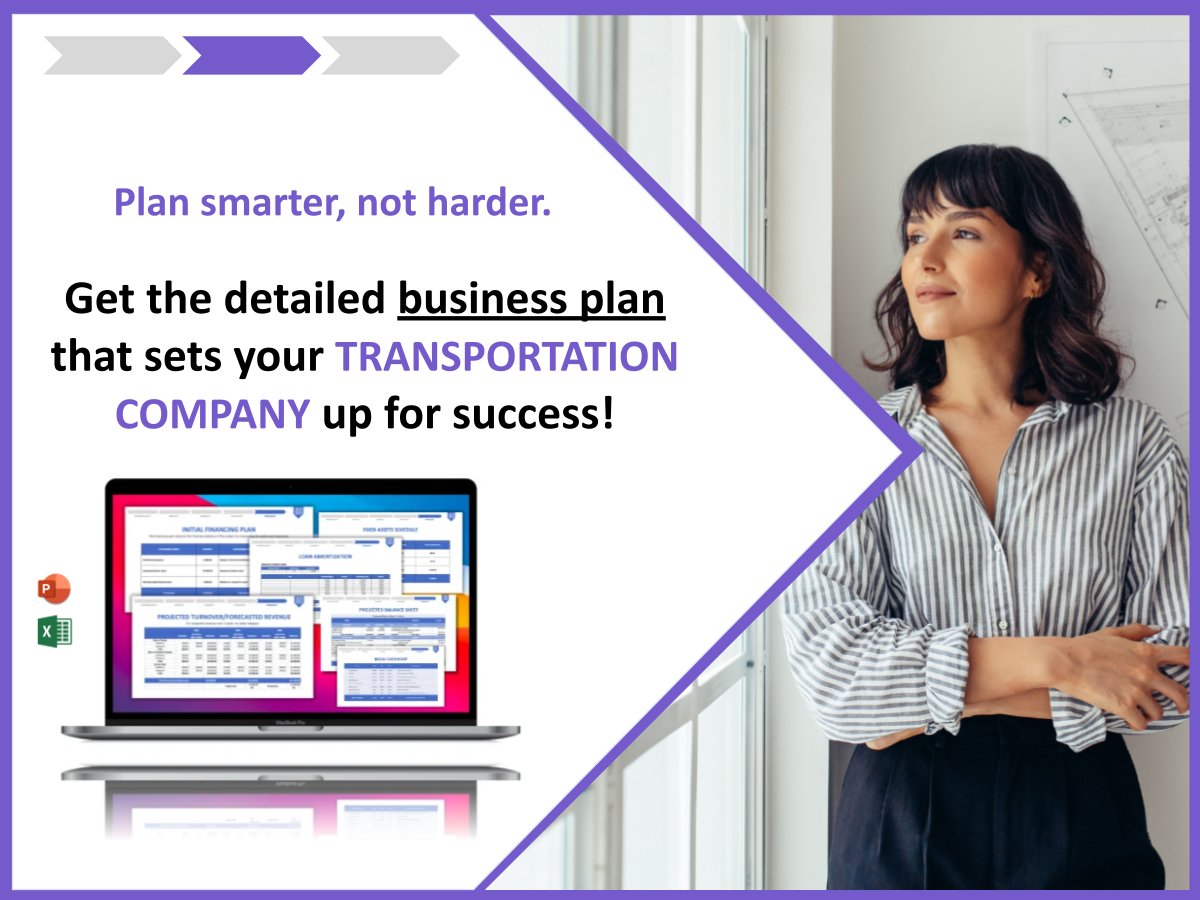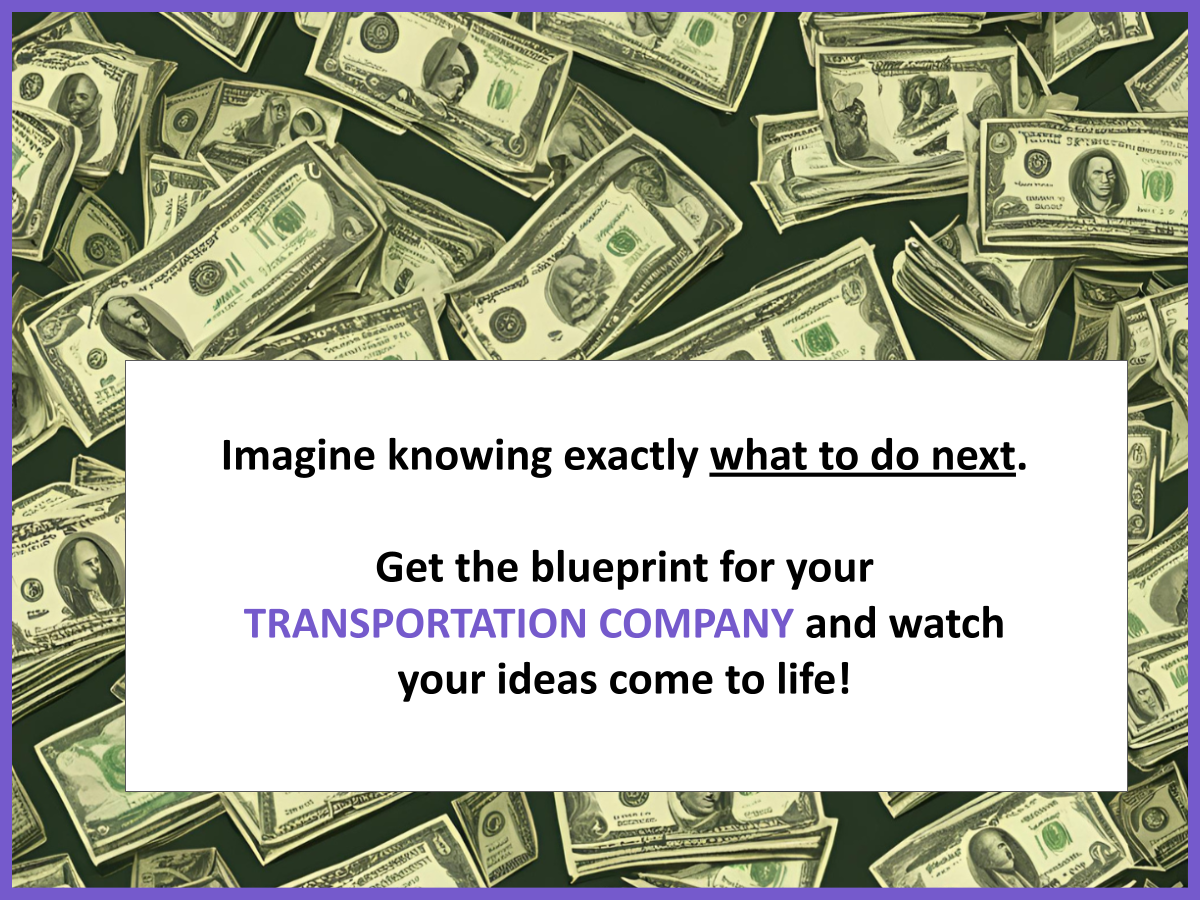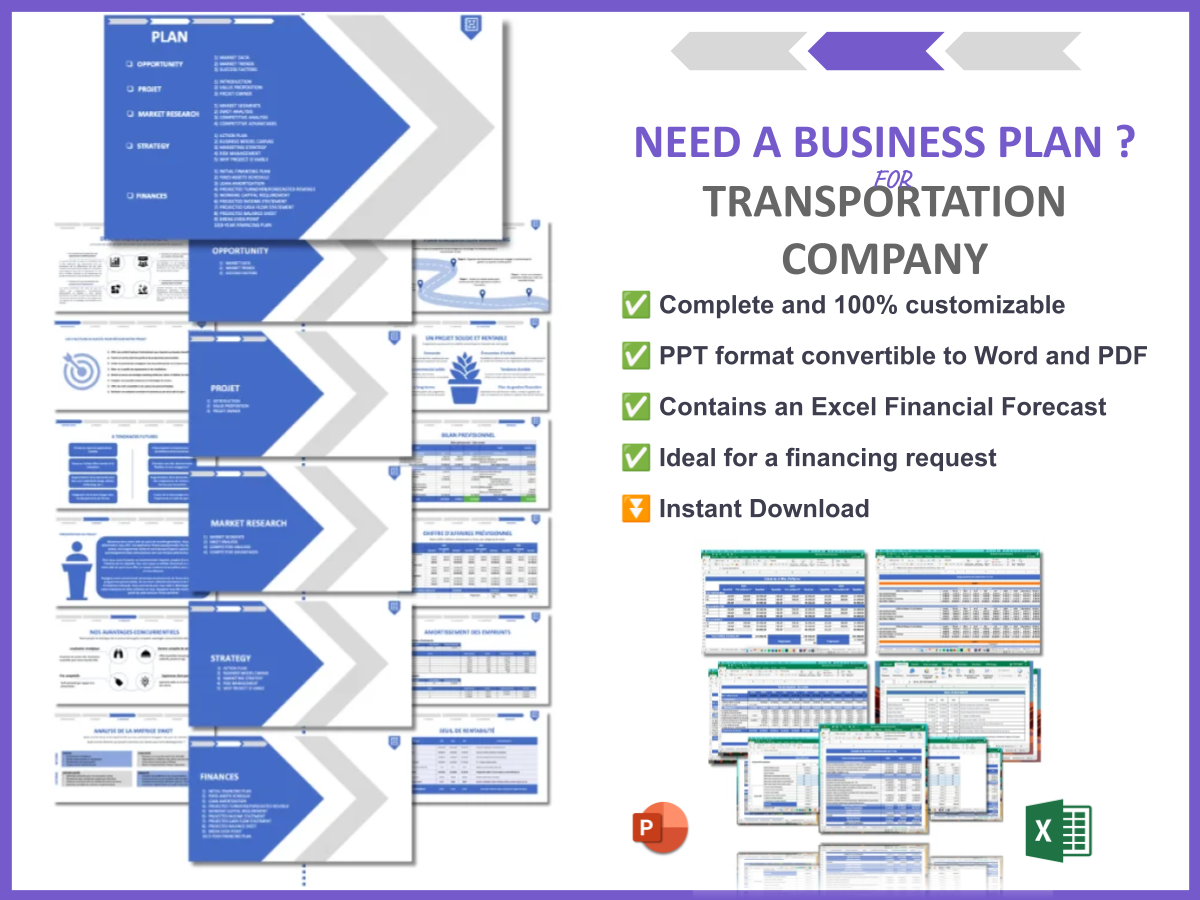Are you thinking about starting a transportation company? You’re not alone! The transportation industry is booming, with an increasing demand for logistics, freight, and delivery services. In fact, the sector is expected to grow by over 4% annually in the coming years. Understanding how to start a transportation company can be your gateway to financial independence and entrepreneurial success. This guide will walk you through essential steps, providing insights and tips to help you launch your business smoothly.
In this article, we will cover:
- Identifying your niche in the transportation industry
- Conducting market research and analyzing competition
- Creating a comprehensive business plan
- Choosing the right legal structure
- Securing funding and financial resources
- Registering your business and obtaining necessary licenses
1. Identify Your Niche in the Transportation Industry
Starting a transportation company begins with identifying your niche. Are you thinking about how to start a transportation company that focuses on freight, logistics, or perhaps passenger transport? Each niche has its unique requirements and market dynamics.
Consider the following points:
- What type of transportation services are in demand in your area?
- What are your interests and strengths?
- What resources do you already have?
Researching your local market will help you narrow down your focus. You might find opportunities in last-mile delivery or even specialized freight services. For instance, if you live in a bustling urban area, there may be a high demand for delivery services. Alternatively, if you’re in a rural area, freight services might be more viable. Understanding your local demographics and logistics needs is essential for making informed decisions.
2. Conduct Market Research and Analyze Your Competition
Next up, you need to conduct thorough market research. Understanding your target audience and competition is crucial. What are others doing, and how can you do it better?
Market research allows you to gather insights about consumer preferences, industry trends, and potential challenges. Here are some methods you can use:
- Surveys and Questionnaires: Collect feedback from potential customers.
- Industry Reports: Analyze existing reports on transportation trends.
- Social Media Listening: Monitor discussions related to transportation services.
To visualize your competitive landscape, consider creating a comparison table:
| Aspect | Your Company | Competitor A | Competitor B |
|---|---|---|---|
| Service Offered | Freight and Logistics | Passenger Transport | Delivery Services |
| Pricing | Competitive | High | Low |
| Customer Feedback | Positive | Mixed | Negative |
Analyze your findings to position your services effectively. Are there gaps in the market that you can fill? This can give you a significant advantage. For example, if you notice that your competitors have poor customer service ratings, focusing on exceptional customer support could set you apart. By understanding what your competitors are doing well and where they fall short, you can tailor your offerings to meet the needs of your target audience.
3. Create a Comprehensive Business Plan for Your Transportation Company
Now, it’s time to put your ideas on paper. A solid business plan is essential for any startup, including a transportation company. It outlines your goals, strategies, and financial projections, serving as a roadmap for your business.
Your business plan should include:
- Executive Summary: A brief overview of your business, mission, and vision.
- Market Analysis: Insights from your research on demand, competition, and target audience.
- Marketing Strategy: How you plan to attract and retain customers.
- Financial Projections: Revenue forecasts, funding needs, and break-even analysis.
I recommend checking out this business plan template for Transportation Company. It’s super detailed and can save you a ton of time! Having a well-structured business plan will not only help you clarify your vision but also attract potential investors or lenders.
Here’s a simple outline for your business plan:
| Section | Details |
|---|---|
| Executive Summary | Brief introduction to your business and objectives. |
| Company Description | Information about your transportation services and your mission. |
| Market Analysis | Insights into industry trends and competitor analysis. |
| Organization & Management | Structure of your business and team roles. |
| Marketing Strategy | How you will reach your target audience. |
| Funding Request | Amount of funding needed and how it will be used. |
| Financial Projections | Revenue forecasts and break-even analysis. |
4. Choose the Right Legal Structure for Your Transportation Business
Choosing a legal structure is a critical step in how to start a transportation company. Will you operate as a sole proprietorship, partnership, or corporation? Each structure has its pros and cons that can affect your taxes, liability, and business operations.
Here are some common structures to consider:
- Sole Proprietorship: Easiest to set up, but you have unlimited personal liability.
- Limited Liability Company (LLC): Provides personal liability protection and is more flexible.
- Corporation: Attracts investors and offers limited liability, but has more regulations.
Each structure has its pros and cons:
| Legal Structure | Pros | Cons |
|---|---|---|
| Sole Proprietorship | Simple to set up | Unlimited personal liability |
| LLC | Limited liability protection | More paperwork |
| Corporation | Attracts investors | Complex regulations |
Consult a legal expert to help you decide which structure is best for your needs. This decision is crucial because it will impact your business’s tax obligations and liability. Take your time to weigh the options and choose what aligns with your long-term goals.
5. Secure Funding and Financial Resources for Your Transportation Company
Funding is often one of the biggest hurdles for new businesses. Determining how much capital you need to get started and exploring your options is essential for how to start a transportation company.
Here are some common funding sources:
- Personal Savings: Using your own savings can provide a quick source of funding without the need for loans.
- Bank Loans: Traditional loans can help you cover startup costs but usually require a solid business plan and good credit.
- Investors: Attracting investors can provide the capital you need, but you’ll need to give up some ownership in return.
- Crowdfunding: Platforms like Kickstarter or GoFundMe allow you to raise money from the public.
When considering your funding options, think about how much you need, how quickly you need it, and what you’re willing to give up in return. A detailed financial projection will help you present a strong case to potential lenders or investors.
Here’s a simple breakdown of potential startup costs you should consider:
| Expense Category | Estimated Cost |
|---|---|
| Vehicle Purchase or Lease | $20,000 – $100,000 |
| Licenses and Permits | $500 – $2,000 |
| Insurance | $1,000 – $5,000 |
| Marketing and Advertising | $1,000 – $5,000 |
| Office Supplies and Equipment | $500 – $2,000 |
Make sure to plan for both initial expenses and ongoing operational costs. Having a clear financial strategy will help you manage your resources effectively as you start your journey.
6. Register Your Transportation Business
Once you’ve settled on a name and structure, it’s time to register your business. This makes it official and allows you to operate legally, which is crucial in the transportation industry.
Here are the steps you need to follow to register your business:
- Choose a Business Name: Make sure it’s unique and reflects your services.
- File the Necessary Paperwork: This typically involves submitting forms to your local government.
- Obtain a Business License: Depending on your location, this may be required to operate legally.
- Register for Taxes: Get an Employer Identification Number (EIN) from the IRS if you plan to hire employees.
Make sure you check local regulations, as they can vary widely from one state or city to another. It’s a good idea to consult with a business attorney or a local business development center to ensure you’re following all necessary legal steps.
Additionally, consider joining local business associations or chambers of commerce. They can provide valuable resources and networking opportunities that can help you as you establish your business.
7. Obtain Necessary Licenses and Permits for Your Transportation Company
To operate legally, you’ll need specific licenses and permits, which can vary depending on your location and the type of transportation services you offer. This step is crucial in how to start a transportation company and ensures that you comply with local and federal regulations.
Here’s a quick checklist of common licenses and permits you may need:
- Commercial Driver’s License (CDL): Required for drivers operating large vehicles.
- Business Operating License: A general license required for running a business in your area.
- Vehicle Registration: Ensures that your vehicles are legally registered for operation.
- Insurance Certificates: Proof of insurance coverage for your business and vehicles.
- Special Permits: Depending on your services, you may need additional permits for freight transport or hazardous materials.
Research your state’s requirements thoroughly to avoid any legal issues. You can usually find this information on your state’s transportation department website. Additionally, consulting with a local attorney specializing in business law can help you navigate the complexities of licensing.
Being proactive about obtaining the necessary licenses not only keeps your business compliant but also builds credibility with your customers. Remember, operating without the required permits can lead to fines or even closure of your business.
8. Apply for Business Insurance Coverage for Your Transportation Company
Insurance is crucial in the transportation industry. It protects your business from potential risks and liabilities, ensuring that you’re covered in case of accidents, damages, or legal issues.
Consider these types of insurance:
- Liability Insurance: Protects your business from claims resulting from injuries or accidents involving your vehicles.
- Vehicle Insurance: Covers damages to your vehicles and liabilities in case of accidents.
- Workers’ Compensation Insurance: Required if you have employees, this insurance covers medical expenses and lost wages for work-related injuries.
- Cargo Insurance: Protects the goods you transport in case of theft or damage.
Consult with an insurance agent who specializes in transportation businesses to help you find the best coverage for your needs. They can help you evaluate risks and choose policies that offer adequate protection without breaking the bank.
Here’s a simple breakdown of how much you might expect to pay for different types of insurance:
| Insurance Type | Estimated Annual Cost |
|---|---|
| Liability Insurance | $1,200 – $3,000 |
| Vehicle Insurance | $2,000 – $5,000 |
| Workers’ Compensation | $500 – $2,000 |
| Cargo Insurance | $800 – $1,500 |
Investing in the right insurance not only protects your assets but also provides peace of mind as you launch your transportation company. Make sure to review your policies regularly to adjust for any changes in your business operations.
9. Set Up Your Financial Management Systems
Effective financial management is key to your success. Setting up systems to track income, expenses, and cash flow is crucial when learning how to start a transportation company. A solid financial foundation will help you make informed decisions as your business grows.
Here are some essential components of a good financial management system:
- Accounting Software: Consider using software like QuickBooks or FreshBooks to manage invoices and expenses.
- Bank Accounts: Open a dedicated business bank account to keep personal and business finances separate.
- Budgeting: Create a budget that outlines expected income and expenses to help you plan for the future.
- Financial Reports: Regularly generate reports like profit and loss statements to monitor your financial health.
To help you visualize your financial situation, consider tracking your cash flow with a simple table:
| Month | Income | Expenses | Net Cash Flow |
|---|---|---|---|
| January | $10,000 | $7,000 | $3,000 |
| February | $12,000 | $8,500 | $3,500 |
| March | $15,000 | $9,000 | $6,000 |
Regularly reviewing your financial performance will allow you to identify trends and make necessary adjustments. Don’t hesitate to consult with a financial advisor to ensure your systems are set up for success.
10. Establish Your Brand Identity for Your Transportation Company
Your brand is how customers perceive your business, and establishing a strong brand identity will help you stand out in a competitive market. A well-defined brand can attract customers and build loyalty, which is essential for your success in how to start a transportation company.
To create a compelling brand identity, consider the following elements:
- Company Logo: Design a professional logo that reflects your business values and services.
- Tagline: Craft a memorable tagline that summarizes your brand promise.
- Brand Colors: Choose colors that convey the emotions you want your customers to associate with your business.
- Consistent Messaging: Ensure that your marketing materials, website, and social media reflect a unified voice and message.
Additionally, think about how you want to position your brand in the market. Are you a premium service provider or a budget-friendly option? This decision will impact your branding strategy.
Here’s a simple checklist for building your brand:
- Define your mission and vision.
- Identify your target audience.
- Create visual elements (logo, colors, fonts).
- Develop your brand voice and messaging.
- Implement your branding across all platforms.
By investing time in developing a strong brand identity, you’ll create a lasting impression on potential customers, which is crucial for driving growth in your transportation business.
11. Develop a Professional Website for Your Transportation Company
In today’s digital age, having a professional website is non-negotiable. It serves as your online storefront, showcasing your services and making it easier for customers to find you. When considering how to start a transportation company, a well-designed website can significantly enhance your credibility.
Your website should include:
- Service Descriptions: Clearly outline the transportation services you offer, including any specializations.
- Contact Information: Provide multiple ways for potential customers to reach you, including phone, email, and a contact form.
- Customer Testimonials: Positive reviews from satisfied clients can build trust and encourage new customers to choose your services.
- Blog or Resources Section: Sharing valuable content can position you as an industry expert and improve your search engine rankings.
Consider using a website builder like WordPress or Wix if you’re not tech-savvy. These platforms offer user-friendly templates that can help you create a professional-looking site without needing extensive coding knowledge.
To give you an idea of what a website might include, here’s a simple layout:
| Page | Content |
|---|---|
| Home | Overview of services and company mission |
| About Us | Company history and team introduction |
| Services | Detailed descriptions of transportation services |
| Testimonials | Reviews from previous clients |
| Contact | Contact form and information |
Investing in a professional website not only enhances your brand image but also serves as a valuable tool for attracting and converting potential customers.
12. Market and Advertise Your Transportation Company
Once everything is set up, it’s time to market your services. Use a mix of traditional and digital marketing strategies to reach your target audience effectively. Marketing is a vital component of how to start a transportation company and will help you build your customer base.
Here are some effective marketing strategies:
- Social Media Advertising: Platforms like Facebook and Instagram can help you reach a broader audience.
- Search Engine Optimization (SEO): Optimize your website for search engines to improve visibility.
- Networking with Local Businesses: Partner with local businesses that may need transportation services.
- Email Marketing: Build an email list to keep potential and current customers informed about your services and promotions.
Tracking your marketing efforts is crucial to understanding what works best for your business. Here’s a simple method for measuring your marketing effectiveness:
| Marketing Channel | Cost | Leads Generated | Conversion Rate |
|---|---|---|---|
| Social Media | $500 | 50 | 10% |
| Email Marketing | $300 | 30 | 15% |
| SEO | $700 | 70 | 20% |
Regularly review your marketing strategies and adjust based on performance to ensure you’re getting the best return on your investment.
13. Assemble Your Team for Your Transportation Company
Finally, you need a reliable team to help run your business. Hiring the right people can make or break your company. When considering how to start a transportation company, think about the key roles you’ll need to fill.
Consider the following roles:
- Drivers: Qualified drivers are the backbone of your transportation company, so ensure they have the necessary licenses and training.
- Logistics Coordinators: They will manage routes and schedules, ensuring efficient operations.
- Customer Service Representatives: Excellent customer service can set you apart from competitors and foster loyalty.
Investing time in training and building a positive company culture is essential. Here’s a simple checklist to guide your hiring process:
- Define job roles and responsibilities.
- Develop a hiring plan and timeline.
- Conduct interviews and background checks.
- Provide training for all new hires.
- Establish clear communication channels within the team.
By assembling a strong team and fostering a supportive work environment, you’ll create a foundation for success as you launch your transportation company. Remember, your employees are your greatest asset!
Conclusion
Starting a transportation company can be an incredibly rewarding venture. By following the steps outlined in this guide, you’ll be well-equipped to navigate the complexities of the industry. From identifying your niche to assembling a strong team, each step is crucial in building a successful business. Remember, the key to long-term success lies in thorough planning and execution.
As you embark on this exciting journey, consider diving deeper into essential topics like creating a SWOT analysis for your transportation company. You can read more about this in our article on how to create a SWOT Analysis for Transportation Company. Additionally, understanding how to market your services is vital, so don’t miss our guide on How to Create a Transportation Company Marketing Plan? With Example. These resources will provide you with valuable insights that can help you thrive in the competitive transportation landscape.
FAQ
- What are the startup costs for a transportation company?
The startup costs for a transportation company can vary widely based on the services offered. Typical expenses include vehicle purchase or lease, insurance, licenses, and marketing, which can range from $20,000 to $100,000 or more. - What type of insurance do I need for my transportation business?
Essential insurance types include liability insurance, vehicle insurance, workers’ compensation, and cargo insurance. These policies protect your business from various risks associated with transportation. - How do I find clients for my transportation company?
You can find clients through networking, online marketing, social media advertising, and building relationships with local businesses that may need transportation services. - What licenses do I need to operate a transportation business?
Required licenses often include a commercial driver’s license (CDL), business operating license, vehicle registration, and specific permits depending on your service type. - How can I differentiate my transportation company from competitors?
Focus on providing exceptional customer service, specialized services, and effective marketing strategies. Building a strong brand identity can also help you stand out in a crowded market. - What are the most common types of transportation businesses?
Common types include freight transportation, logistics services, delivery services, and passenger transport. Each niche has its unique requirements and target audience. - How important is a business plan for a transportation company?
A business plan is crucial as it outlines your goals, strategies, and financial projections. It serves as a roadmap and can help attract investors or secure loans. - Can I operate a transportation business from home?
Yes, many transportation businesses can be operated from home, especially if you focus on logistics or dispatching services. However, you may need a dedicated office space for operations. - What are the key challenges in the transportation industry?
Common challenges include regulatory compliance, managing operational costs, maintaining vehicle maintenance, and dealing with competition. - How can technology improve my transportation business?
Technology can streamline operations through route optimization software, GPS tracking, and automated scheduling, improving efficiency and customer satisfaction.

